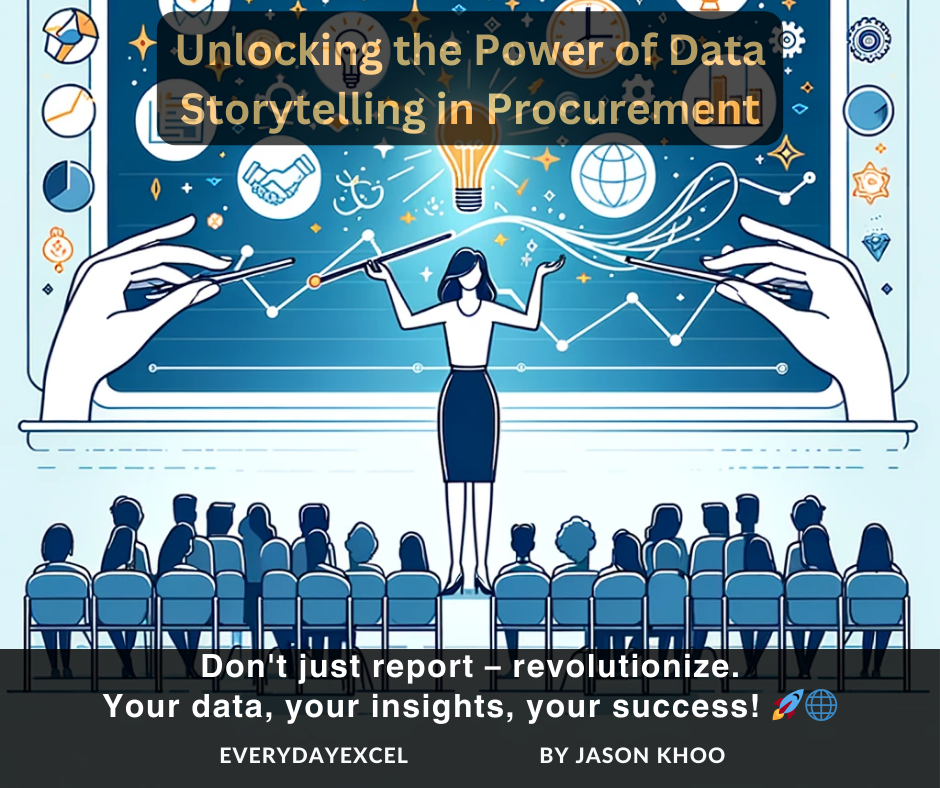
data storytelling
Unlocking the Power of Data Storytelling in Procurement

In the bustling office of a leading manufacturing company, Rebecca meticulously prepared for her monthly ritual. As a procurement manager, her role was pivotal, bridging the critical gap between her company’s operations and its multitude of suppliers. Each month, with the precision of a seasoned expert, she would update the supplier dashboard, a comprehensive template that detailed the performance of suppliers and the delivery time of supplies. To Rebecca, this dashboard was the epitome of clarity and efficiency, a clear mirror reflecting the health of supply chain relationships and operational flow.
However, this month felt different. As she reviewed her slides, a familiar feeling of redundancy crept in. She had always believed the numbers spoke for themselves, that the graphs and tables needed no further explanation. But the blank faces and stifled yawns during her past presentations haunted her. It was evident; her audience was disconnected from the story her numbers desperately tried to tell.
It was during one of her preparatory sessions, deep in thought and surrounded by piles of reports and analytics, that Rebecca stumbled upon an article about data storytelling. The concept was simple yet revolutionary: transforming data from mere numbers on a dashboard into a compelling narrative. This approach promised not just to present data but to weave it into a story that highlighted its significance, drawing the audience in and making the abstract tangibly relevant to them.
Intrigued, Rebecca decided to pivot. She spent the next days reimagining her presentation. Instead of starting with cold, hard figures, she began with a narrative. “Imagine a month where our key supplier faced an unexpected shutdown,” she would say, painting a vivid picture of the potential chaos, then guiding her audience through the dashboard’s tale of how the company navigated this challenge, highlighted by the data points that showed delayed deliveries, but also the strategies implemented to mitigate these disruptions.
She introduced characters into her story—the supplier, the delivery team, the end consumer—all roles affected by the numbers on her dashboard. Each metric was no longer just a statistic but a chapter in a larger saga of resilience, innovation, and collaboration.
The day of the presentation arrived. As Rebecca unfolded her narrative, interlacing the data with stories of challenges, solutions, and triumphs, she noticed a shift. Eyes that once glazed over were now locked in, questions flowed more freely, and discussions became more animated. Her colleagues began to see the numbers as she did: indicators of a journey, filled with hurdles and victories.

This newfound approach transformed Rebecca’s presentations from routine reports to engaging stories that captivated her audience. Her dashboard, once a static display of metrics, became the foundation of a narrative that highlighted achievements, identified opportunities for improvement, and fostered a deeper understanding of the supply chain’s dynamics.
Through data storytelling, Rebecca not only redefined her role as a procurement manager but also enhanced the way her team interacted with data. They were no longer just looking at numbers; they were reading a story—a story of their collective effort, challenges, and successes. This shift didn’t just change the way they viewed reports; it changed how they approached their work, making every number, every graph, a page in their ongoing story of striving for excellence.
What is Data Storytelling
Data storytelling is like turning numbers into a storybook. Imagine you have a bunch of photos from a vacation. Each photo tells a part of your adventure, but when you share them with friends, you weave them into a story, explaining the context, your feelings, and why certain moments were memorable. Data storytelling does the same but with numbers and data from reports or studies. It’s not just about showing graphs and charts; it’s about telling the story behind those numbers—what they mean, why they matter, and how they affect us.
Why Is Data Storytelling Important?
- Makes Data Understandable: Not everyone loves looking at rows of numbers or complex graphs. Data storytelling translates those numbers into a narrative that’s easier to grasp. Just like a good story captures our attention, data storytelling makes complex information engaging and accessible to everyone, not just data experts.
- Drives Decision Making: When data is presented as a story, it’s easier for people to understand the implications and make informed decisions. A well-told data story can highlight trends, successes, or issues in a way that prompts action, making it a powerful tool in business, education, and many other fields.
- Creates a Connection: Stories connect with us emotionally, and when data is woven into a narrative, it can create an emotional response. This connection can make the information more memorable and persuasive, encouraging people to care about what the data is telling them.
Benefits of Data Storytelling
- Improved Engagement: People are more likely to pay attention and engage with information when it’s presented in a story format. Data stories can capture the audience’s imagination and keep them interested in what the data has to say.
- Better Retention: Stories are memorable. When data is presented as part of a narrative, people are more likely to remember the message. This is crucial for educators, marketers, and anyone trying to communicate complex information.
- Enhanced Communication: Data storytelling bridges the gap between data scientists and non-experts. It enables people without a background in data analysis to understand complex information, making communication more effective across different parts of an organization or community.
- Encourages Action: A compelling data story can highlight critical insights and trends that might be missed in traditional data presentations. By clearly showing the significance of data, storytelling can inspire actions that lead to improvement and growth.
In simple terms, data storytelling turns the chore of digesting numbers into an engaging experience. It brings data to life, making it not just informative but also compelling. Whether it’s in business, education, or everyday life, data storytelling is a powerful tool for illuminating the truth hidden in the numbers and inspiring action based on that truth.
